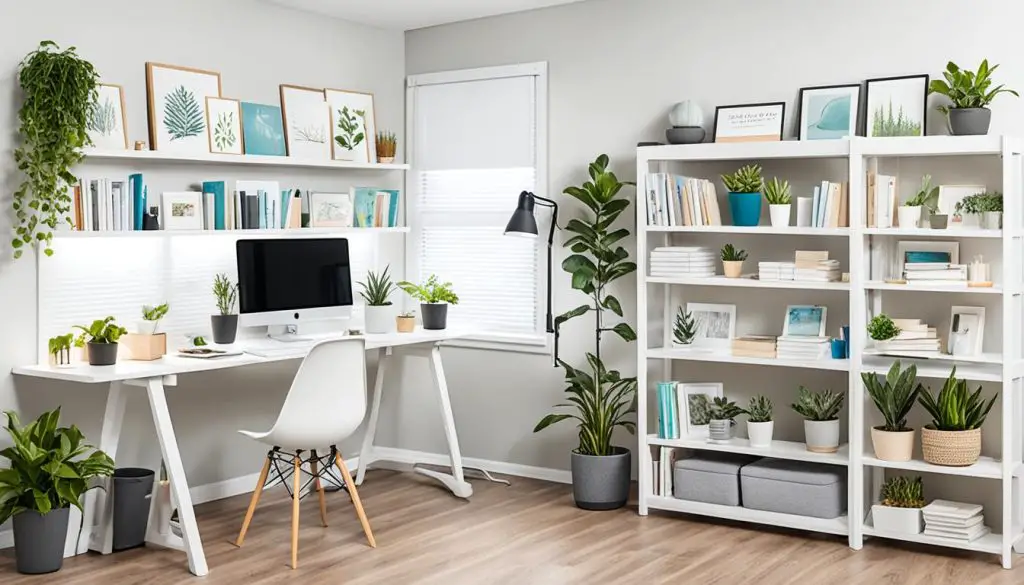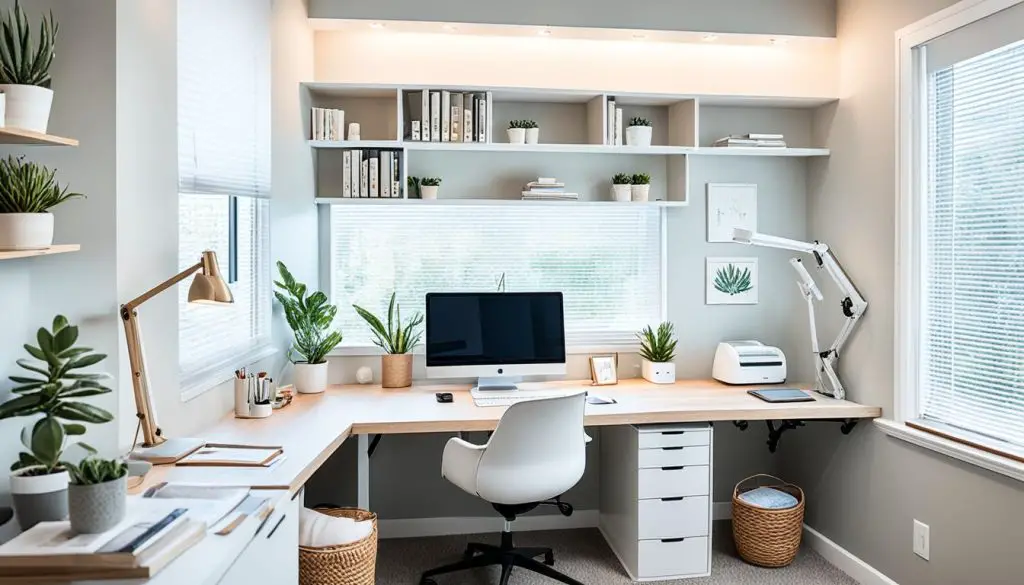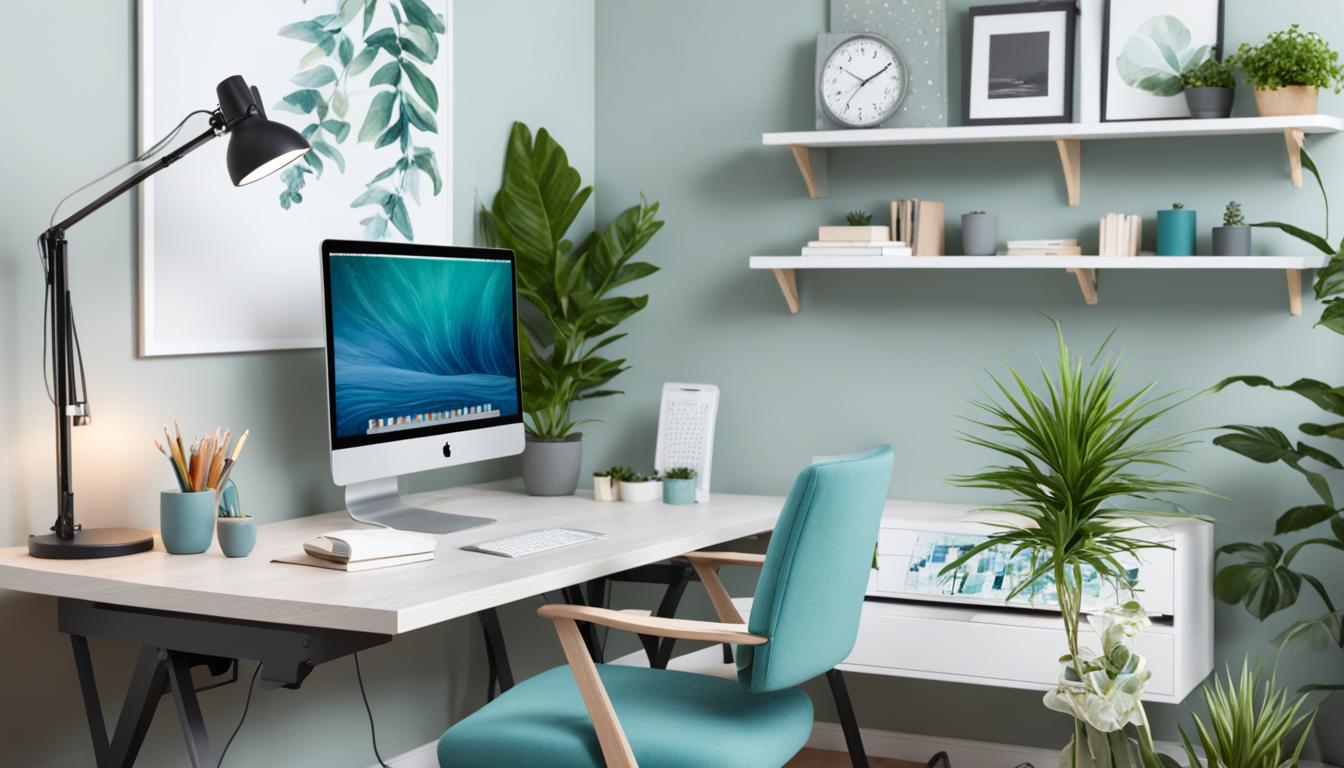Imagine if your home could change into a haven. This place would meet your long-term care requirements. It would also boost your success at work. I’ve experienced this with my wife, who battles endometriosis and fibromyalgia. A well-designed home office greatly improved her life and work output.1
Today, a big portion of adults, about 34%, are living with a long-term health issue. For some, it’s two or more. The number of people facing these challenges is rising. Soon, half of the U.S. will have a chronic illness. Staying home becomes the best choice but most houses aren’t made for those with medical needs.
What if your home could be reimagined to merge beauty with purpose? This kind of transformation is the magic of interior design. It lets you stay at home safely, effectively, and stylishly as the years pass.1,2
Customizing your space is the essence of home design for chronic illness. Every detail fits your needs now and in the future. By knowing your life, hurdles, and wishes, designers craft a place where you can flourish. Your health struggles won’t stop you from living well.
Transforming Your Home for Long-Term Care Needs
Designing a home for someone with a chronic illness involves looking at their current health and lifestyle. An expert observes a typical day. They note difficulties in morning routines, eating, and getting clean3. The goal is to create a design that helps now and as their health changes. This design looks to be more than just following basic rules. It wants to truly make the home easy to use and fit the person’s needs uniquely.
Prioritizing Comfort and Quality of Life
Choosing the right tech, equipment, and spaces for care is key in many homes. They sometimes need to adapt to offer the best living space for those with long-term health needs.3 Help at home for those who are sick has been happening for a long time, more than 200 years. In 1990, a big report suggested more help should be available at home, showing the government cares about this issue3.
Interior Design Creativity for Disability Accommodation
In 1910, 20% of Americans had life insurance for home care. This was especially common among those who didn’t have much money. Also, in 1916, about nine out of ten people getting care from this insurance were white. This shows a big difference between white and Black people’s access to care3. Nearly three quarters of those getting care were women. Most of them were expecting mothers. This special care was often needed by women, and not just for mothers. About a third of those who needed care had short-term problems, but nine percent needed care for a long time. This highlights how important long-term care has always been3.
In 1909, the Metropolitan Life Insurance Company started paying for nursing care at home. This showed businesses cared about improving care access3. They aimed to stop early deaths through home nursing based on what they learned in New York City. This results-based care began to grow across the U.S. in 1911, with help from other care groups. The company used smart ways to manage cases to make sure insurance covered everything well. This highlights the value of smart care planning3.
Personalized and Futuristic Approach to Home Remodeling
The design process starts by learning about the person’s health and life.4 Designers look at a day with a chronic illness. They see the big hurdles, like stairs or high cabinets.4 This info helps make changes that really fit the person’s needs.
Understanding Your Current Health Situation
Chronic illnesses change over time. So, designers think about what the person will need in the future, too.4 They plan changes to last, adapting the home once instead of many times.4 The aim is to keep the home helpful as the person’s health changes.
Projecting Long-Term Needs for a One-Time Renovation
Designers make homes for today and tomorrow. This way, the space always meets the person’s health needs.4 It’s a smooth process that keeps costs and stress low. The home ends up being a perfect place, helping the person live freely for years.
Going Beyond ADA Guidelines for True Accessibility
Starting with ADA compliance is great for public spaces. Yet, when it comes to homes, we must aim higher than just the basics.5 To truly make a home accessible, design has to be more personal. It may even go against common ADA rules. For example, a ramp’s slope might be adjusted for easier walker use. The main aim is to make the living space perfect for the person’s needs, not just okay for accessibility.
Designers don’t just meet ADA rules; they step further for customized and real accessibility. They might change common ideas to better fit the individual. This ensures the space is truly comfortable and helpful for everyone’s unique needs.
In the end, the home doesn’t just pass a checkmark for being accessible. It’s designed from the ground up to fully support the resident. This whole approach puts the person’s unique needs first. It helps them live more independently and comfortably. In their own living space, they thrive.
Integrating Assistive Equipment and Technology
Most homes weren’t made with those needing extra help in mind. They often have narrow hallways and small spaces that are hard to use with mobility aids. Designers are changing this by making more room and wider doorways. They work to fit any current or future needs for care and equipment.4 Adding smart home features and voice software also makes life better for those with long-term illnesses.4
Creating Spacious Pathways for Mobility Aids
To make moving around easier, homes are now designed with wider spaces and clear paths. This way, people can freely move using walkers, wheelchairs, or other aids. Paying attention to easy access is key in giving a home that’s truly welcoming for those with special needs.
Designing for Present and Future Assistance Needs
Designers think about what help may be needed in the future. They make changes that will keep on being useful as time goes by.4 This way, the home can change and adapt with the person. This reduces how often the place needs to be renovated.4
Chronic Illness Home Office: Style and Function
Living with chronic illness and working from home? Having a special home office space can be life-changing. It can help blend style and function smoothly. This space should be ergonomic and adaptable. It should help you work better while keeping you physically and mentally healthy.2 It might include things like adjustable furniture, lots of natural light, and areas for relaxation. These elements come together to form a beautiful and motivating workspace.
Over a third of remote workers prefer to work from home full-time. This makes the design of your home office even more important if you have a chronic illness. A space that meets your unique needs and supports working remotely with a chronic illness is essential. It helps you do well in your job while taking care of your health.
| Design Feature | Benefit |
|---|---|
| Adjustable Furniture | Supports physical comfort and ergonomics |
| Ample Natural Light | Enhances mood and productivity |
| Relaxation Areas | Provides respite and stress relief |
Designing your home office for productivity and health is a smart move. It lets people with chronic illnesses set up a workplace where they can shine. This space supports both your work and your well-being.
Prioritizing Pain Management in Design
Living with chronic illness involves dealing with constant pain. This could be either physical or mental.4 Designers consider this when creating living spaces. They add things that can help ease pain and offer support. For example, for those with arthritis, a cozy bathtub can help soothe aching joints. If someone is on the autism spectrum, the design might focus on noise-reducing elements. These would lessen auditory stress. The main aim is to make spaces that promote independence and comfort. This should also meet the person’s unique pain management and aid needs.
Warm Baths for Arthritis Relief
Arthritis can make every day a challenge. A warm bathtub turns the home into a healing sanctuary. Warm water reduces swelling and helps ease pain. This lets arthritis patients manage their condition better and keep their freedom. Such a simple addition can make a big difference to their quality of life.
Noise-Muting Materials for Sensory Sensitivities
Sensory issues and autism can make home life hard. Designers focus on using materials that dampen sound. They cover walls and floors with these. Creating a quiet, cozy zone aids in handling sound sensitivities. It also prevents too much stimulation, allowing a better home life.

Fostering Independence Through Holistic Design
The approach in design always looks at the bigger picture. It’s not just about the physical and therapy goals. It also taps into what helps emotionally and mentally.4 This means they look at what the person’s life was like before they got sick. Their likes, hobbies, and the people they love are key.4 Then, the design adds features that keep these parts of their life vibrant. This aims to make them feel more independent and like things are normal.4 For instance, a cozy space for visitors might be nestled close to the bed. This makes it easy for friends and family to stop by. The focus is on creating a place that supports all parts of a person, not just the medical ones.
Incorporating Therapy Goals
This design strategy aims to help with both health and happiness. It’s all about making living with a chronic condition better. By adding things that help with moving, feeling good, and personal choices, freedom grows.4 Designing homes for chronic health issues should consider what each person really needs. It goes past just meeting laws like ADA, but tailoring spaces for comfort and managing pain.4 Helping at home with pain and making things easier improves life a lot for those dealing with long-term health issues.4
Designing for Hobbies and Interests
No two people face a chronic condition the same way. So, home designs should be made to fit their unique needs. If a health problem makes it hard to do daily tasks, the home design can make it simpler.4 For example, homes might get changed to offer easier ways to get around. This makes it easier for the person and those around them to move without difficulty.4 When designing for different health issues like arthritis or dementia, the plan should fit the disease stage. This makes sure the home works well to meet changing needs.4
Embracing Biophilic Design for Mental Health
Biophilic design is vital in designing homes for people with chronic illnesses. It focuses on bringing nature indoors. This includes using skylights, large windows, and natural materials. Also, adding houseplants or living walls is part of it. These features can deeply impact mental health. They help lower stress and increase calm and well-being.6
Bringing the Outdoors Inside
Simple touches like plants and light can boost mood and life quality.7 Being in natural light can enhance sleep, strengthen the immune system, and lessen anxiety and depression.7 Plus, green areas in cities are tied to less stress, better thinking, and more exercise.7
Houseplants and Natural Lighting
Elements of biophilic design, such as skylights and large windows, foster well-being. They work well for those with ongoing health issues.6 Using poor work areas can lead to stress and job dissatisfaction. That’s why natural light and plants are key for home offices in these situations.7
By following biophilic design, people with health conditions can make spaces that heal.6 This approach boosts happiness, cuts stress, and improves thinking.7 It’s a big help for those facing the tough parts of chronic illness daily.
Aesthetically Pleasing and Functional Design
Designing a home for someone with a chronic illness is more than just making it accessible. It’s about making it looking nice too. Universal design is used to not only make the home work for everyone but also to hide any signs of disability. The aim is to build a space that’s both beautiful and empowering, not just a place that meets medical needs.
De-emphasizing Disability, Empowering Ability
Using universal design in the home lets people with chronic illnesses live without their disability being the main focus.8 This means the home is functional and looks great too. Designers make sure the home is unique to the person living in it, not just clinically designed.
The right materials, lighting, and layout make the home a place of peace and health for its owner.8 Adding in universal design, the home stays stylish and comfy, but also works for everyone’s needs.
Designing for Specific Chronic Illnesses
The design process changes based on the illness someone lives with. For those with arthritis at home, we might add counters and appliances that change heights. There could be lots of seats for tasks, grab bars, and kitchen tools that fit better in the hand.4 If it’s dementia or Alzheimer’s, the home’s design might have cameras, photos with names, clear cabinet doors, smart devices, and other safety and memory aids.4 Always, the designer and the person talk a lot to make a space that suits their health needs and makes life easier.
Arthritis Home Modifications
Home design for arthritis focuses on making life easier. It includes countertops and appliances that you can adjust, lowering the need to bend. Also, there are comfy chairs for when you need to sit, grab bars in the right places, and tools for the kitchen designed to be easy to use.4 The idea is to create a home where someone with arthritis can do things on their own without too much difficulty.
Dementia and Alzheimer’s Accommodation
For those with dementia or Alzheimer’s, the design is about safety and keeping things familiar as the illness goes on. This might mean putting up cameras, labeling family photos, having see-through cabinet doors, using smart tech, and making sure there’s enough light to prevent falls.4 By thinking ahead about what someone will need as their memory changes, the design helps keep them independent and enjoying life through every step of their illness.

| Chronic Illness | Home Design Considerations |
|---|---|
| Arthritis | Countertops and appliances that can be adjusted, lots of seating for tasks, grab bars, slip-resistant mats, kitchen tools that are easy to use4 |
| Dementia/Alzheimer’s | Cameras to ensure safety, photos with names, cabinets with clear doors, tech to help, good lighting4 |
The Benefits of Remote Work for Chronic Illness
Working from home can change life for those with chronic illness. It lets them work at their best, without draining themselves. They can rest when they need without bothering others.
A small percent worked from home all the time. But a big chunk in the US and some in the EU did it now and then, even before the pandemic hit.9
Flexible Scheduling to Maximize Productivity
The setup at home is key. It should help you work better without tiring you out. Things like comfy chairs, good light, and a cozy spot to relax in can make a big difference. They can be set up especially for people with health challenges.9
Privacy and Comfort for Personal Needs
Home is the best place to handle health issues quietly and comfortably. It allows for peace to deal with pain, tiredness, or just a break. And most times, you can’t tell someone is sick just by looking at them. So, it’s really important to have a private and supportive setup.10
Voice Recognition Software for Accessibility
Tech like voice recognition makes work easier for many. It helps people with movement issues still be productive. Lots of adults have long-term health problems. With the right tech, they can do well working from home.10
Expanding the Talent Pool with Inclusive Hiring
Companies should look at all the talented people facing chronic illness or disability. Many can do well in jobs they can do from home.11 By hiring from this group, a company gets new skills and shows it values all kinds of people.11 It also shows they care about inclusivity and diversity. Helping employees with chronic conditions means more than just giving them a job. It’s about making a workplace that meets their needs and is supportive.
Supporting Employees with Chronic Conditions
Workers facing health issues need some special support. This might mean working hours that fit them, using tools that help, and understanding that they also might care for someone else full-time. Companies that help in these ways find that their team is stronger, with a mix of backgrounds and skills. This makes the business more successful in the end.
Caregiver Roles and Remote Work
For those caring for others, being able to work from home can be a big help. It lets them juggle their job with caring for a family member. This way, they can do well at work and also take care of their loved ones properly.
With hiring more broadly and supporting those facing health challenges and caregiving, companies gain. They find good, dedicated workers they might have missed before. This not only helps the individuals but also makes the business better overall. It leads to a more varied, engaged, and strong team.
Interior Design for Wellness and Healing
I’ve learned how crucial interior design is while living with a chronic illness. My home’s look and feel provide more than basic comfort. It’s a key part of my healing journey. Natural elements like sunlight, plants, and wood uplift my mind and soul.8
Choosing the right colors and arranging things well makes my home a soothing place. Ergonomic furniture and easy access to help create a healing haven. It supports me through my illness’s challenges.
This way of designing my living space has changed everything for me. It aligns with my wellness goals and supports my healing. Now, I can thrive despite my illness issues.
Source Links
- https://hpi.georgetown.edu/workplace/
- https://www.businessnewsdaily.com/10041-manage-chronic-illness-at-work.html
- https://www.ncbi.nlm.nih.gov/pmc/articles/PMC2690354/
- https://liveinplacedesigns.com/how-home-design-can-help-you-live-with-a-chronic-illness-or-condition/
- https://adata.org/factsheet/health
- https://sheararchitecturaldesign.co.uk/the-impact-of-biophilic-design-on-health-and-well-being-in-modern-homes/
- https://www.linkedin.com/pulse/healing-power-architecture-how-urban-design-impacts-mental
- https://www.julieannrachelle.com/blended-decor-blog/wellness-design-for-chronic-illness
- https://www.ncbi.nlm.nih.gov/pmc/articles/PMC8998114/
- https://www.linkedin.com/pulse/remote-work-lifesaver-those-chronic-conditions-hennigan-she-her-
- https://www.bentley.edu/news/leveraging-disabilities-workplace
